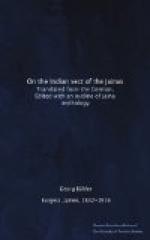THE INDIAN SECT OF THE JAINAS.
The Jaina sect is a religious society of modern India, at variance to Brahmanism, and possesses undoubted claims on the interest of all friends of Indian history. This claim is based partly on the peculiarities of their doctrines and customs, which present several resemblances to those of Buddhism, but, above all, on the fact that it was founded in the same period as the latter.
Larger and smaller communities of Jainas or Arhata,—that is followers of the prophet, who is generally called simply the Jina—’the conqueror of the world’,—or the Arhat—’the holy one’,—are to be found in almost every important Indian town, particularly among the merchant class. In some provinces of the West and North-west, in Gujarat, Rajputana, and the Panjab, as also in the Dravidian districts in the south,—especially in Kanara,—they are numerous; and, owing to the influence of their wealth, they take a prominent place. They do not, however, present a compact mass, but are divided into two rival branches—the Digambara and [’S]vetambara [Footnote: In notes on the Jainas, one often finds the view expressed, that the Digambaras belong only to the south, and the [’S]vetambaras to the north. This is by no means the case. The former in the Panjab, in eastern Rajputana and in the North West Provinces, are just as numerous, if not more so, than the latter, and also appear here and there in western Rajputana and Gujarat: see Indian Antiquary, vol. VII, p. 28.]—each of which is split up into several subdivisions. The Digambara, that is, “those whose robe is the atmosphere,” owe their name to the circumstance that they regard absolute nudity as the indispensable sign of holiness, [Footnote: The ascetics of lower rank, now called Pa[n.][d.]it, now-a-days wear the costume of the country. The Bha[t.][t.]araka, the heads of the sect, usually wrap themselves in a large cloth (chadr). They lay it off during meals. A disciple then rings a bell as a sign that entrance is forbidden (Ind. Ant. loc. cit.). When the present custom first arose cannot be ascertained. From the description of the Chinese pilgrim Hiuen Tsiang (St. Julien, Vie. p. 224), who calls them Li-hi, it appears that they were still faithful to their principles in the beginning of the seventh century A.D. “The Li-hi (Nirgranthis) distinguish themselves by leaving their bodies naked and pulling out their hair. Their skin is all cracked, their feet are hard and chapped: like rotting trees that one sees near rivers."]—though the advance of civilization has compelled them to depart from the practice of their theory. The [’S]vetambara, that is, “they who are clothed in white”—do not claim this doctrine, but hold it as possible that the holy ones, who clothe themselves, may also attain the highest goal. They allow, however, that the




